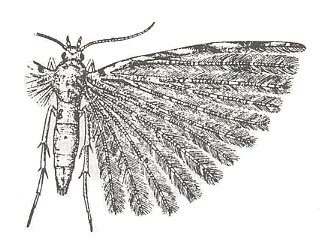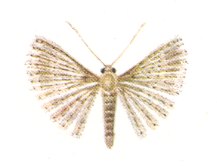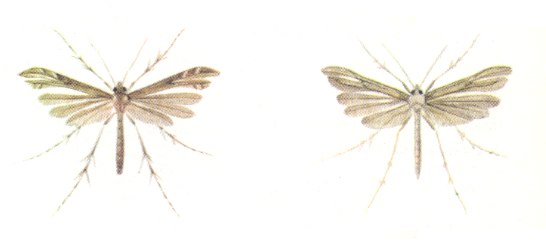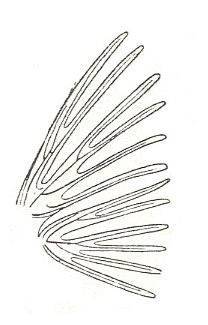

e-mail :  ( Please write in ' Subject ' entry : ' METAPHYSICS ', in order for me to be able to distinguish your mail from spam )
( Please write in ' Subject ' entry : ' METAPHYSICS ', in order for me to be able to distinguish your mail from spam )
Examples best expressing type :

Figure 1 : Orneodes pygmaea, Ceylon (Sri Lanka), Family Orneodidae (Alucitidae : Many-plume Moths), Lepidoptera.
(After FLETCHER, in RICHARDS and DAVIES, 1977)

Figure 2 : Orneodes desmodactyla, Europe. Wing span 8 mm. The complete set of wings consists of 24 "fingers". Family Orneodidae (Alucitidae : Many-plume Moths), Lepidoptera.
(After SEVERA, in THIEME's Insektengids, 1977)

Figure 3 :
Left : Pterophorus pilosellae, Europe. Wing-span 9 mm. Family Pterophoridae, Plume Moths), Lepidoptera.
Right : Pterophorus monodactylus, Europe, Asia Minor, N.America. Wing-span 12 mm.
(After SEVERA, in THIEME's Insektengids, 1977)
Description of the type
Morphological features
Both pairs of wings little different from one another -- homonomy moderately disturbed. Skeleton of thorax and muscular apparatus not investigated, and probably little different from those in platypterygia. Wings elongate, divided by deep incisions resulting in narrow long lobes ('fingers') (from 2 to 6), each consisting of a longitudinal vein, fringed by the membrane. The wing is covered with long scales -- hairs, especially long at the margins of the lobes. Wing-venation rather rare, not costalized, serving as skeleton of the lobes of the wing. The shape of the body doesn't display special aerodynamic adaptations. Body elongate with long legs.
Functional features
Flight not yet investigated, evaluation of it must be based on indirect considerations. Both pairs of wings participate in wing-beat, thereby do move simultaneously, evident from the presence of a special attaching device (frenulum). Speed of flight and wing-beat frequency not known exactly, but certainly not great. Maneuverability and persistence of flight not investigated. Also absent are data on wing-beat frequency, load, and other parameters of flight features.
These remarkable insects, possessing such an unusual wing structure, forcing to erect for them a special type, undoubtedly realize a flight of a special nature. The main features of dactylopterygia allow them to be compared, on the one hand, with broad-wingedness (platypterygia), and, on the other, with feather-wingedness (ptilopterygia). In all these types the chief direction in evolution consists in maximum decrease of load per unit of wing-surface. This was realized in different ways. Probably, one of the important reasons of these differences were the absolute sizes of the insects, that is, their weight, which is very low in the representatives of feather-wingedness, large in the type of broad-wingedness, and medium in the representatives of the present type, finger-wingedness. See also next Figure.

Figure 4 : Wings of Orneodes sp. Family Orneodidae, Order Lepidoptera. (After HANDLIRSCH, in ROHDENDORF, 1949)
Differentiation, connections and representatives of the type.
e-mail :
 ( Please write in ' Subject ' entry : ' METAPHYSICS ', in order for me to be able to distinguish your mail from spam )
( Please write in ' Subject ' entry : ' METAPHYSICS ', in order for me to be able to distinguish your mail from spam )
To continue click HERE for further study of the types of flight-devices in insects, Part XII, Uropterygia.
Back to first part of theoretic intermezzo
Back to second part of theoretic intermezzo Back to Part IX